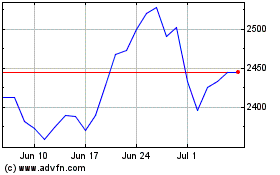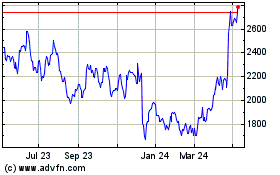CESCO: Anglo American: Future Copper Mine Growth Seen Limited To Larger Players
April 16 2012 - 2:30AM
Dow Jones News
Future copper mine growth will be a matter of survival of the
fittest, and eventually filter down to a limited number of market
participants due to the challenges developing new supplies will
hold, the head of Anglo American PLC's (AAUKY, AAL.LN) copper
division told Dow Jones Newswires.
John MacKenzie said during an interview in the annual CESCO
industry week in Santiago that because all the "easy" copper is
already being developed or in production, the increased challenges
will eliminate players unable to handle the scale necessary to make
them work.
"As you get into lower grades in the future, and remoter areas,
those tend to require scale to make them work, and tend to require
massive infrastructure investment, rail, ports, power," he said. "I
do think the scale of what is going to be needed to make those
projects economic is going to limit the number of players who can
actually develop those sorts of projects."
The situation works both ways, he noted, "as it is obviously
going to start defining what the incentive price has to be for
those resources to be developed, but it does take a leap of faith
that those prices are going to remain the same when you are going
to be investing many, many billions of dollars in a new
project."
The trend toward developing copper mines in more remote, risky
or challenging terrains has risen over the last decade as mining
firms raced to snap up prospective deposits. Congo, Afghanistan and
Pakistan have all moved firmly onto the radar of mining companies,
but with some attached costs.
"As a generalization for the copper industry, people are going
to have to start going to some of the more challenging places to
develop new production, and I think with that comes costs,"
MacKenzie said. "Prices of copper have risen fourfold in the last 8
years but margins haven't done the same. Costs have risen, and are
being hard-coded into the market now, so I don't think in the next
price cycle decline either operating or capital costs will vanish.
What makes copper in our view an attractive commodity for the
foreseeable future is the challenges in bringing sufficient supply
on to meet that demand."
Challenges for existing mines include declining grades, mines
having to go deeper or underground, complexities around
infrastructure, power and water availability, and rising labor, raw
materials, community and environmental costs or requirements, he
told Dow Jones.
"What we're also seeing is that the process of bringing on new
supply has had a history of disappointing. If one looks at
previously announced dates of when projects would be developed,
those having been moving steadily outwards, and all the factors
causing that are unlikely to go away," he said.
This means the industry is "still playing catch-up, ten years
after the copper bull run started, on the supply side," MacKenzie
said. "Even with the best will in the world, it is not that easy to
bring new supply on, so I think we will see some supply coming on
but what we believe is that you need quite a lot more to meet the
forecast demand. Even with those projects that have a high
probability of being developed, those will still leave
deficits."
Anglo is forecasting a copper market supply-demand deficit in
2012, moving into a small surplus "for a year or two" as new
projects come onstream and then returning to further market
deficits.
Turning to the demand side, MacKenzie said Anglo American's view
of the copper market "remains very, very positive," with China, the
world's largest copper consumer, continuing to lead the way in
consumption growth, despite recent signs of slowing.
"By 2020 we see China will account for over half of all copper
consumption in the world. We don't see that demand picture
fundamentally changing," he added.
-By Andrea Hotter, Dow Jones Newswires; +44 (0)20 7842 9413;
andrea.hotter@dowjones.com
Anglo American (LSE:AAL)
Historical Stock Chart
From Mar 2024 to Apr 2024

Anglo American (LSE:AAL)
Historical Stock Chart
From Apr 2023 to Apr 2024
